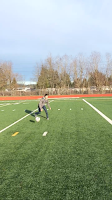Natural makeup is one of the biggest mysteries out there, mostly because the term 'natural' is used very loosely. Natural simply means that no matter the amount of makeup you apply, you are aiming to look as if you are not wearing any at all. Today I have decided to use Jemma Kidd's
Makeup Masterclass to help me achieve the perfect natural makeup look. This is part one of the look, where I will be working on the base of the look. Today I will be working on foundation, concealer, powder, blush, and more.
Before attempting this look, I would like to show how I have previously done natural makeup on myself:
As you can tell, the base is natural foundation/powder shade-wise, but the cheek area is very unnatural blush/contour wise.
For the base of the natural look you will need:
Liquid Foundation in your closest shade (When finding foundation, swatch off of the back of your arm rather than your hand, as it is closest to your skin tone)
Powder (translucent or foundation powder)
 |
| After |
Color correcting concealer
Concealer a shade lighter than your skin tone (this is to brigten features)
Blush
Kabuki or Powder brush
Foundation Brush or Beauty Blender
 |
| NYX Color Correcting Concealer |
To start off my base look, following Kidd's instruction, I began with foundation. When doing your foundation, Kidd states "Even out skin tone using either a light liquid foundation, or a mineral foundation if your skin is prone to oiliness." I used my Revlon '24Hr Colorstay' for combination/oily skin in the shade 'Toast.' This is the foundation I previously explained about in my last blog post, and it is mineral infused which is perfect for my skin according to Kidd. I used a 'Beauty Blender' to dab the product into my skin and blend.
Next, I used NYX color correcting concealer. Color correcting concealer is green, to contrast redness on skin. Then I went over the green with regular concealer, as Kidd states "Hide any blemishes with dabs of concealer"
 |
| After blending |
 |
| After application of blush and powder |
After applying concealer, Kidd instructs for olive skinned people that "if you've used a liquid foundation, set with a light dusting of translucent or foundation powder, then give the apples of the cheeks a natural flush using a blend of soft peach and sandy beige powder blush." I used a foundation powder to set my makeup, and added a Peachy Beige LA Colors blush over top. Blending the powder with an ELF Kabuki Brush and an angled contour brush for Blush.
And with that, my base of the natural look was finished! overall I think it turned out well. There were many noticeable differences to my face, however they look very natural and are hard to pinpoint unless you had seen my face before the application! I also find this natural base to look much more natural and flawless than my previous natural makeup look that I showed in the beginning. Overall I have improved much more on my natural base and am very happy with the result! My question to you all is how do you think I did? what do you think I should do to improve my natural base?

















































